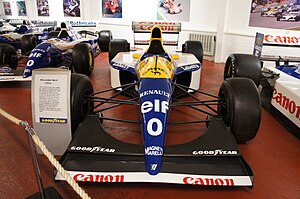Williams FW15C
 |
|||||||||
| Category | Formula One | ||||||||
|---|---|---|---|---|---|---|---|---|---|
| Constructor | Williams | ||||||||
| Designer(s) |
Patrick Head (Technical Director) Adrian Newey (Chief Designer) |
||||||||
| Predecessor | FW14 | ||||||||
| Successor | FW16 | ||||||||
| Technical specifications | |||||||||
| Chassis | Carbon fibre and Aramid monocoque | ||||||||
| Suspension (front) | Pushrod, Williams hydropneumatic active suspension system | ||||||||
| Suspension (rear) | Pushrod, Williams hydropneumatic active suspension system | ||||||||
| Axle track | Front: 1,670 mm (66 in) Rear: 1,600 mm (63 in) |
||||||||
| Wheelbase | 2,921 mm (115.0 in) | ||||||||
| Engine | Renault RS5, 3,493 cc (213.2 cu in), 67° V10, NA, mid-engine, longitudinally mounted | ||||||||
| Transmission | Williams 6-speed semi-automatic | ||||||||
| Weight | 505 kg (1,113 lb) | ||||||||
| Fuel | Elf | ||||||||
| Tyres | Goodyear | ||||||||
| Competition history | |||||||||
| Notable entrants | Canon Williams Renault | ||||||||
| Notable drivers | 0. 2. |
||||||||
| Debut | 1993 South African Grand Prix | ||||||||
|
|||||||||
| Constructors' Championships | 1 (1993) | ||||||||
| Drivers' Championships | 1 (1993, Alain Prost) | ||||||||
The Williams FW15C was a Renault-powered Formula One car designed by Adrian Newey and built by Williams Grand Prix Engineering. It was raced by Alain Prost and Damon Hill during the 1993 Formula One season.
As the car that won both the drivers' and Constructors' Championships in the last season before the FIA banned electronic driver aids, the FW15C has a decent claim to be the most technologically sophisticated Formula One car of all time, incorporating anti-lock brakes, traction control and active suspension.
The original FW15 was a new car designed in 1992 to incorporate the active suspension changes developed and implemented on the earlier FW14B. The FW14B had initially been designed as a passive car (FW14) and had been pushed into being active. This meant it had various new active components implemented on the car which had not been in the original design brief. It was therefore considered a bloated and relatively overweight package. The original FW15 was an active car from the start which enabled a much tidier package closer to the minimum weight limit. The success of the FW14B meant that the FW15 was not needed in 1992.
The FW15B was a 1992 FW15 hastily converted to the 1993 regulations featuring narrow-track front suspension, narrower tyres, raised nose and wing endplates and narrower wings to enable early season testing for 1993.
Building on the hugely successful FW14B which took Nigel Mansell and Williams to both titles in 1992, the car was the first all-new car to be produced by Patrick Head and Adrian Newey in collaboration (Head had designed many of Williams's previous cars, while Newey had designed cars for the March and Leyton House Racing teams). With Newey's input aerodynamically the FW15 was a significant improvement on its predecessor, with a narrower nose, sleeker airbox and engine cover and carefully sculpted sidepods. Another new feature was the larger rear wing used at high-downforce circuits which featured an extra element ahead and above the main wing (similar to the 'winglets' seen in Grand Prix racing in 1983 and 1984).
...
Wikipedia
